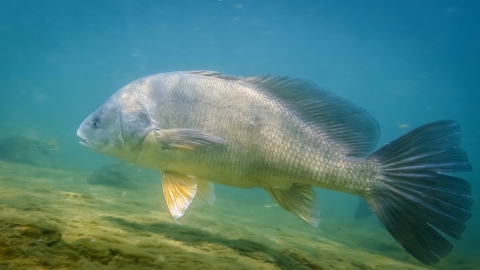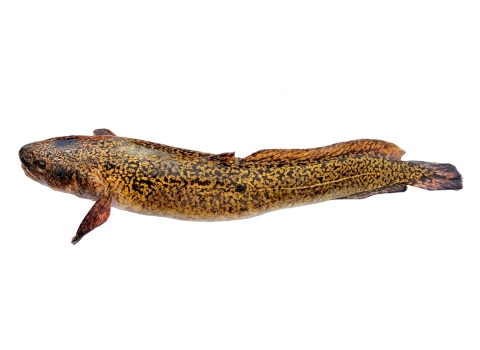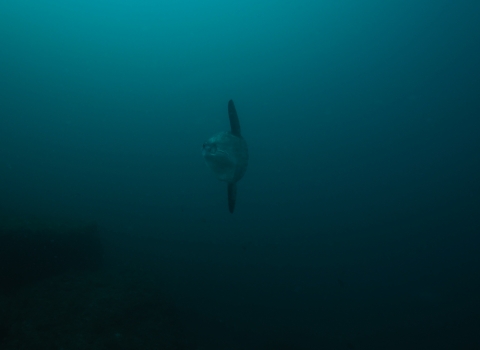Amongst the freshwater fishes of North America, there exists a loose hierarchy of fame and public awareness. The fish near the top of that hierarchy are often those with the largest fisheries—the largemouth bass and rainbow trout that legions of (justifiably) excited anglers get up at the crack of dawn to feel on the end of their line. And while we’d never dream of disparaging those iconic species, some of the most widespread, unique, beautiful, tasty, and hard-fighting fish can often live under the shadow of those giants. Bringing appreciation to these spectacular finned friends is something our podcast strives to do, and today we’re putting the magnifying glass on one of the most prime examples of these fish. Meet the musical fish with a dozen names that lives in a million lakes and streams across our continent: Aplodinotus grunniens, the Freshwater Drum!
All-American Superstar
Though the drum family Sciaenidae comprises nearly three hundred species, the vast majority of them are marine fish that spend the bulk of their lives in the world’s oceans. In fact, the Freshwater Drum is the only species of drum in North America that lives entirely within freshwater! From Guatemala to Ontario, and Appalachia to Texas, these silvery-gray fish inhabit lakes, ponds, rivers, and streams of all kinds. That massive distribution might explain why the freshwater drum has such a huge variety of common names! There are just too many to list here, but some favorites include sheephead, gou, goats, gooble gobble, Russell fish, thunder pumper, or Gaspergoo. While preferring clear waters with sand or gravel bottom, Freshwater Drum can tolerate more turbid conditions if necessary. With their deep bodies and powerful tails, they’re just as comfortable in flowing rivers as they are traversing massive lakes.
Wherever they live, one thing is a constant: these fish love to crunch some shells! Freshwater drum diets are mostly made up of benthic invertebrates like crayfish, insect larvae, and especially mussels. That includes mussel public enemy #1, the infamously fast-growing invasive zebra mussels that plague many American waterways. Though Freshwater Drum aren’t able to curb the spread of those mussels on their own, they’ll happily munch on the invaders when they come across an appropriately-sized cluster. Their underslung jaw structure is similar to that of their saltwater cousins, the red and black drums, optimized for picking up tasty morsels from the bottom. From there, the drum’s powerful crushers at the back of the mouth make quick work of the toughest exoskeletons our waters have to offer. However, smaller fish higher in the water column are hardly off the menu—freshwater drum will seasonally change their diet to include fish such as young gizzard shad. During the autumn months, these baitfish have been found to comprise over half of the diet for freshwater drum in some areas.
Piscine Percussionists
Now, you might well be wondering if the “drum” part of “freshwater drum” is just some vestigial linguistic quirk that’s made it into the species’ common name. Rest assured, the name is fully and completely deserved! A characteristic adaptation seen in the whole drum family are specialized abdominal muscles that surround their air-filled swim bladder. Drum can make those muscles vibrate against the swim bladder, producing a deep thudding or buzzing sound not unlike their namesake instrument. When adults school up in shallow water during their spawn, the sound of all those fish drumming together can be loud enough to hear on the surface or even from shore! The purpose of this sound may be used for attracting mates, as well as communication during feeding or when stressed. Check out these recordings by Roundtree and Juanes (2017) of the drumming sound to hear the symphony!
Beautiful and Brawny
A deep-bodied fish with a noticeably notched dorsal fin, freshwater drum range in color from bright silver to a coppery brown depending on water conditions in their habitat. As our podcast guests noted, drum may also exhibit some beautiful iridescent patterns on their gill plates:
"Those purple iridescent colors that show up and drum too for certain watersheds and regions...I've been out with very novice anglers and having never seen a drum before. They were just amazed. They were like, "This is the most beautiful thing" looking at the cheek of a Freshwater Drum. That purple is something pretty special."
"One thing that I think is really neat about them is they have the really big caudal fin...And the pectoral fins are really long and pointed...and they hold them out, kind of like wings when they're just sort of drifting through the shallows. So they have a really elegant method of swimming that I think is just really notable with them."
While the average Freshwater Drum might range from a couple pounds to well over ten depending on your region, they can grow to some pretty impressive sizes. Bruisers over thirty pounds are hardly unheard of, and the world record from Nickajack Lake in Tennessee topped fifty! These giants of the species have some serious life experience, too. After reaching maturity at four to six years of age, Freshwater Drum can live for well over fifty years in some cases. Adults tend to spawn in shallower water during June and July, broadcast spawning in open water to fertilize clutches of eggs numbering in the tens of thousands. Fertilized eggs float to the surface, where the larval drum hatch after a few days.
During their first year of life, baby freshwater drum eat a lot of zooplankton and try their best to avoid the numerous predatory fish looking for their next meal. These include lots of the iconic sportfish species that cohabitate with Freshwater Drum such as Walleye, Largemouth and Smallmouth Bass, and Yellow Perch. After that first year, humans become the main predator of freshwater drum, which are often caught as bycatch while chasing the aforementioned species.
That status as bycatch is part of freshwater drum’s reputation as an undesirable rough fish, though commercial fisheries for them have long existed throughout their range. Nowadays, many recreational anglers have set their hearts on spreading the good word of the gaspergoo to others. Far from being worthless, Freshwater Drum are large, powerful fighters that readily take a huge spread of baits, lures, and flies! Their red drum relatives are famed for their dogged runs and aggressive strikes, and a hefty Freshwater Drum will put just as large of a bend in your rod as it peels line off the reel.
"Worms on bottom. You can't go wrong with that...Small jigs, crayfish mimics, things like that...Switching up to a shrimp like you're fishing for catfish works really well."
Their reputation as poor table fare is equally underserved, with large fillets of flaky, rich, white meat suitable for pretty much any fish preparation! Texan chef Jesse Griffiths, known for his appreciation of undervalued game and fish, recommends cooking them “on the half-shell”—slang for grilling the fillets skin-side down, scales and all.
The smoky grilled fish can then be easily scooped off the skin, which acts as a barrier to keep the flesh nice and juicy. To reference their famous marine counterparts one final time, red and black drum are celebrated widely for their quality on the table—so next time you find yourself looking at the silvery sides of one of our most widespread fish species, give the freshwater drum its due and join us in the appreciation of #AllTheFish!
More Fish, Please
Catch a new podcast episode of Fish of the Week! every Monday!









